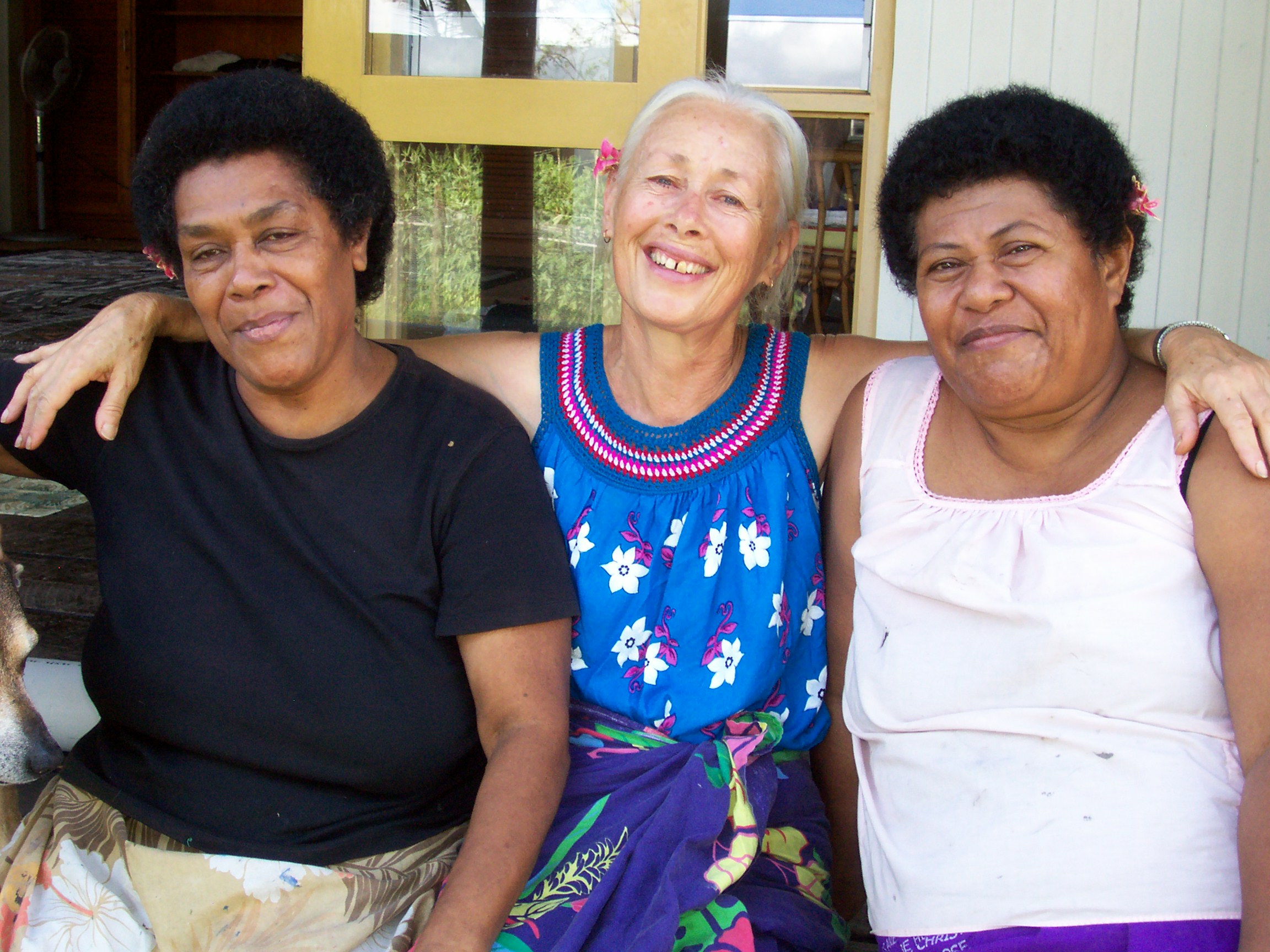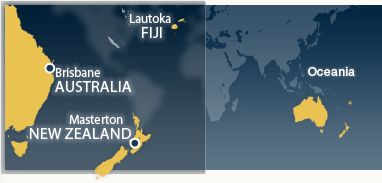
BRISBANE, Australia — Traditional Pacific island bark cloth stenciled with designs depicting a vision of a "New Garden" was one of the artworks commissioned for a prestigious exhibition at the Queensland Art Gallery.
The sixth Asia Pacific Triennial of Contemporary Art – APT6 – is now well into its four-month run and features works by some of the best-known artists of the Pacific region.
Prominent New Zealand artist Robin White was invited to participate, with organizers mentioning a possible collaboration with a tapa artist from Fiji. Eventually Mrs. White proposed that she work with two Fijians, Leba Toki and Bale Jione.
All three artists are Baha'is and used their vision of a future society to inspire their work.
"What we wanted to do was to present our vision of what Fiji could be – and what it will be," said Mrs. White.
In Fiji, she explained, almost all of the world's great religions are represented by a significant portion of the population – Hindu, Muslim, Buddhist, Christian, and a small but growing Baha'i community.
"That makes it special," she said. "Somehow we wanted to get that idea across."

The tapa – or masi, as the Fijians call the craft of tapa and the plant from which it is made – is traditionally made for a wedding, and the artists indeed used that concept.
"The idea was not about a literal wedding between two individuals but rather the idea of a marriage of cultures – namely the indigenous and Indian cultures that constitute contemporary Fijian society – connected by bonds of love and respect," Mrs. White said.
In the end, many elements were incorporated into their tapa. For the main piece, a vision of the Shrine of the Bab in the Holy Land and its surrounding terraces was combined with images of importance to Fijians.
An unusual collaboration
For Mrs. Toki, the mere act of a Fijian like herself collaborating with a New Zealander to create artwork on tapa was a breakthrough.
"I knew that only the Fijians can do the tapa," she said, remembering her skepticism when Mrs. White first contacted her for an earlier project. "I was thinking, 'How can we work together?'"
For Mrs. White, it was during her travels in the Pacific that she had gotten the idea of a collaboration. Already a well-known artist in other media, she had known about the tapa produced in Fiji, Samoa, and Tonga. But when she saw a particularly beautiful piece hanging in the transit lounge in the Nadi airport, she decided she must learn the technique for making it.
In Fiji, she met Mrs. Toki at a Baha'i gathering and later at the Toki residence noticed some beautiful tapa on the wall.
"Who did these?" Mrs. White asked.
The bark cloth itself comes from the bast, or "skin," of the paper mulberry. The outer bark is discarded, the hard inner stalk is used for firewood or staking plants in the garden, and the skin is dried and stored. When required for making masi, the dry strips are soaked in water and then beaten. The strips are overlaid as they are beaten, as in a felting process.
The inner skin of the dogo, or mangrove, provides the raw material for kesa, the liquid paint used for printing the patterns. A stone is used to pound pieces of dogo, which are then boiled to form the kesa.
The pigment for the paint consists of black soot and brown clay, or umea, that is dried and scraped to make a fine power. To produce the soot, a wick is prepared from scraps of bark cloth. This is dipped into kerosene and burned in an enclosed tin oven. The soot collects on the inside upper surface of the oven and is carefully removed and stored in a tin. The soot is mixed with the kesa and umea to make loloa – black paint.
(Source: Robin White)

When she discovered that Mrs. Toki herself was the artist, an idea was born. At first Mrs. Toki was reluctant to work jointly – she had never heard of the type of tapa she did being created by anyone other than Fijians. But when she discovered that Mrs. White indeed was an artist, she was willing to give it a go. And when they began collaborating, she found the relationship rewarding.
"Working together is very powerful," Mrs. Toki says now. "Different races, both giving ideas."
She said a pattern of consultation, action, and reflection - familiar to all three women through their Baha'i activities - became a key part of the creation of their artwork for the APT6 exhibition.
The trio completed their new work several months ago and traveled to Brisbane in early December for the opening of APT6 and to participate in stimulating conversations with other artists from throughout the Asian Pacific region.
The exhibition runs through 5 April.

In Fiji, Mrs. Toki lives in Lautoka, known as Sugar City because of a large sugar mill located in the town. The idea of sugar became one of the starting points for the three artists as they developed concepts for their commissioned work.
"Sugar (became) a metaphor for the sweetening of relationships between people," Mrs. White said, explaining how their thinking progressed.
"The real Sugar City is the city of God," she continued.
This image led the artists to picture the Baha'i gardens and terraces on Mount Carmel in Haifa, Israel - gardens known for their beauty and perfection and thus symbolic of a transformed society, Mrs. White said.
"That seemed like a visual framework," she said.
The main tapa they made shows the Baha'i shrine on Mount Carmel with its terraced gardens. At the base is a sugar plantation. Taro – a food staple in the Pacific that is believed to be one of the earliest cultivated plants – is depicted as growing on the terraces.
That tapa is a large wall hanging, 12 by 8 feet, and is accompanied in the exhibition by a second piece for the floor. The artists also created other elements, including the garments for the "wedding," that also will remain part of the collection at the Queensland Art Gallery.
They named the work "New Garden" – "Teitei Vou" in the Fijian language – words taken from the writings of Baha'u'llah.
The art of the tapa
Mrs. White said the artistic decoration of bark cloth remains part of the culture in Fiji.
"Young girls in the Lau group of islands in Fiji, where Leba and Bale come from, all do this kind of tapa work," she explained, "and some become skillful at doing specialized aspects of it such as designing and cutting stencils. In the village setting, the women all work together. If someone is getting married, the women get together to make the tapa."
"It's a sacred cloth," Mrs. White said. Traditionally it has been used for various occasions and now, with the European influence, is used even more extensively – for tablecloths and other items, for example.
For the artwork for APT6, Mrs. Jione acquired the raw material for making the tapa on her native island of Moce and took it to her current home in Suva, the capital of Fiji which is located on the island of Viti Levu.
There she and her husband worked together to beat it into sheets before taking it across the island to Lautoka where Mrs Toki lives. Mrs. White then joined them in Lautoka for a few months – Fiji is a four-hour flight from New Zealand – and the three artists worked together to make the designs and do the painting.
Mrs. Jione said the stenciling is much easier now than in the old days. Her grandmother, for example, used banana leaves for the stencils, but they were difficult to work with and not very durable. Now the artists use X-ray film, and the stencils can be used over and over.
"Because of film, many more people can do the painting," she said.
In the early stages of the APT6 project, Mrs. White spent time reading about Fiji as part of her preparation.
"I did a lot of research into the history," she said. She discovered how the Fiji of today is a result of indentured laborers being brought from India to work on the sugar plantations, and how Mahatma Gandhi supported efforts to bring the human trafficking to an end.
In recognition of this period of history and the suffering associated with it, the size of the main tapa - 12 by 8 feet - was made in the dimensions of the living quarters issued to the Indian laborers who were obliged to live three to a room.
"Everything in the artwork has significance," Mrs. White said.
More about the APT6 exhibition
The Asia Pacific Triennial of Contemporary Art – now in its sixth edition – runs through early April in the Gallery of Modern Art and the Queensland Art Gallery in Brisbane. The exhibition includes 313 artworks by some 160 artists from 25 countries.
This year's show includes for the first time artists from North Korea, Iran, Turkey, Tibet, Cambodia, and Myanmar - a fact that Mrs. White finds significant. The presence of North Korean artists is particularly interesting, she said.
"To see their work included in the APT seems to me a very important thing," she noted.
The Triennial, she said, brings together artists from diverse backgrounds living in the world's largest land mass and scattered across the world's largest ocean.
"I am fascinated with how culture and belief informs their work," she said of the participating artists. Some of the pieces have a deeply spiritual aspect, she said, and some reflect social or political issues.
She noted that a work that is overtly Baha'i perhaps is more accepted and appreciated here than in many other venues.
Queensland Art Gallery Director Tony Ellwood said collaboration among artists of different countries was a hallmark of the exhibition.
"Much of APT6 draws on the extensive network of relationships, within the region and beyond, that has always been integral to the Triennial's spirit," he said.
In addition to the tapa created by the three Baha'is of New Zealand and Fiji, some of the collaborative art projects in APT6 include "The Mekong," a collection of works from Vietnam, Cambodia, Thailand, and Myanmar, and "Pacific Reggae," a selection of Pacific reggae music videos, concert clips, documentaries, and performances.
For information on APT6, go to www.qag.qld.gov.au/apt6
For the page about the three tapa artists, go to http://qag.qld.gov.au/exhibitions/current/apt6/artists/robin_white,_bale_jione_-and-_leba_toki